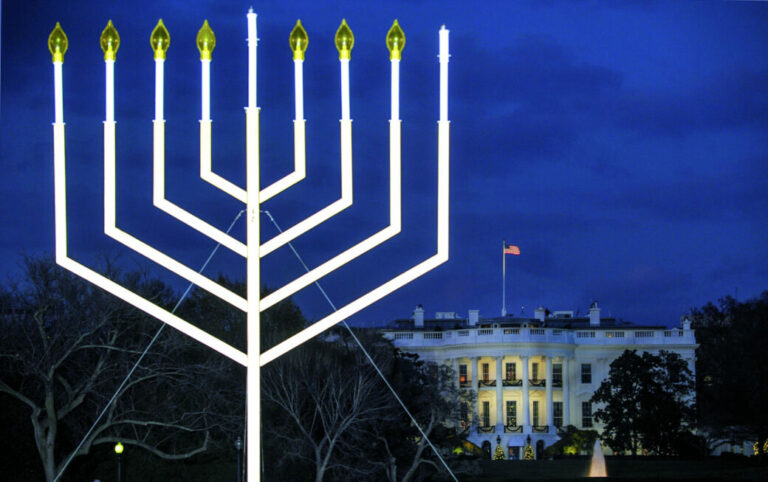by Gabe Harder
Introduction
Doug Wilson’s “American Milk and Honey” is now available. There’s a great deal in the book worth commenting on, and I anticipate engaging with that material more broadly in the near future. In the lead-up to its release, however, Moscow has not been silent concerning Israel, the Jews, and antisemitism. Not only has Wilson himself blogged extensively on these issues, but just the other week Toby Sumpter threw his hat in the ring with a blog post1 largely affirming many of Wilson’s convictions. Then Canon Press published a video of Pastor Wilson and company discussing right-wing Twitter’s response to all this with Andrew Isker.2 While a number of Wilson’s arguments deserve further analysis, I’d like to dedicate this article to examining one of the more curious features of his account; the so-called “covenant with Hagar.”
Allow me to say at the outset that I am personally indebted to Pastor Wilson in terms of my own theological development. My first systematic introduction to covenant theology was ‘To a Thousand Generations.’ I became a postmillennial preterist in large part because of Wilson’s writing and preaching. But this is one reason why I was surprised to find so much of what he has argued of late running contrary to covenantal and eschatological sensibilities I acquired through his influence.
It might be tempting to cast this disagreement entirely in terms of Wilson’s futurist understanding of biblical prophecy concerning the conversion of the Jews vs. the minority preterist reading of James Jordan et al. I trust my sympathies in that debate will show through here. As far as I’m aware, however, Wilson’s particular use of Hagar is unattested even among those exegetes who take the majority Reformed position, making it a true theological novum.
In 2022 Wilson published One New Man, his commentary on Galatians and Ephesians. Though clearly not intended as exhaustive, the commentary never mentions a “covenant with Hagar” for modern unbelieving Jews. Instead, Wilson takes something far closer to the standard Reformed reading. It’s hard to avoid the sense that his “covenant with Hagar” was developed in response to recent controversy, rather than being the product of impartial exegesis.
Given the centrality of the idea to much of Wilson’s content preceding the release of American Milk and Honey, I expected the book to dedicate far more space to “the covenant with Hagar,” including perhaps a defense of his seemingly idiosyncratic new reading of Galatians 4. In reality, the chapter “Children of Hagar” devotes a mere two and a half pages to the concept, and despite it doing quite a bit of heavy lifting, there is never any serious exegetical engagement with the text of Galatians, leaving the ambiguous and bizarre nature of his previous comments to stand.
The Covenant with Hagar
Wilson understands his project as defending what he terms a “soft supersessionism.” Soft supersessionism, “holds that the Jews as a people are still part of God’s purpose and plan for the world,”3 and describes what he regards as the historic Reformed consensus. It quickly becomes apparent, however, that Wilson not only wants to secure a continuing place for the Jews in redemptive history, but that he wants to secure them that place as a covenanted people:
“When the Jews are converted en masse, this will usher in the latter-day glory, and the resurrection of the dead. In short, the status of the Jews with regard to faith and unbelief is relevant to the rest of the world. As some have probably guessed, the arguments presented in this book are coming from a soft supersessionist position. Now one of the questions that will naturally be asked is what covenantal category these severed Jewish branches could possibly have in the meantime.”4
-DW
For Wilson, “[Jewish identity] has always been a matter of covenant, not blood.”5 Therefore, to maintain that the Jews as a people remain part of God’s plan is necessarily to conceive of modern Jews as a people in covenant. His frequent appeal to a “covenant with Hagar” has been one in a number of efforts to locate such an ongoing biblical-covenantal identity. Since being a Jew is a matter of covenant, “for Christians what [the question of Jewish identity] should amount to is whether a tribe of people could bind themselves by covenant to the line of Hagar (Gal. 4:25). And the answer is yes.”6 This is evidently a commitment shared by Toby Sumpter: “It’s simply not true that no covenant remains for unbelieving Jews. It’s a covenant of bondage and slavery, and it is most certainly not the covenant of promise and grace (from which they have been removed), but there is a covenant with unbelieving Jews that remains nonetheless — the covenant with Hagar.”7
“Tell me, you who desire to be under the law, do you not listen to the law? For it is written that Abraham had two sons, one by a slave woman and one by a free woman. But the son of the slave was born according to the flesh, while the son of the free woman was born through promise. Now this may be interpreted allegorically: these women are two covenants. One is from Mount Sinai, bearing children for slavery; she is Hagar. Now Hagar is Mount Sinai in Arabia; she corresponds to the present Jerusalem, for she is in slavery with her children. But the Jerusalem above is free, and she is our mother.”
Galatians 4:21-26
Despite acknowledging Paul’s appeal to the Genesis narrative here as metaphorical8, in some places it actually sounds as though Wilson is arguing that unbelieving Jews are made participants in a historical covenant with Hagar and Ishmael. Language of being covenantally bound “to the line of Hagar” is suggestive of this, as is his insistence that “although the ethnic Jews are descended from Abraham physically, covenantally speaking, they are Ishmaelites.”9 In the recent Canon Press video he argues similarly: “[Ashkenazi Jews] are covenantally bound to, I would argue, the covenant of Hagar in Galatians. So, covenantally they are Ishmaelites, because they have identified with this line that goes all the way back.”10
Elsewhere in the same video Wilson treats the “covenant with Hagar” as though it had its inception in the first century. When Isker says that he would understand the covenant with Hagar to end in AD 70, Wilson responds: “But if Galatians is written in the 40’s, and Jerusalem falls in 70 AD, that’s less than 30 years to have this covenant…It seems odd to me, or just a quirk, that you have this category of a covenant with Hagar that is just so short lived.”11
Regardless of when this covenantal arrangement begins, nothing is clearer than the fact that, for Wilson, the “covenant with Hagar” and its relevance for Jewish identity must carry forward past the first century and into our future:
“The group we commonly call Jews are cultural and ethnic Jews, and they have overwhelmingly rejected Christ as their Messiah. They are consequently under the covenant of Hagar (Gal. 4:24-26). Paul describes it as a covenant of bondage, and there is no indication in the text that this covenant was going to evaporate over time. Chains can be struck off, by faith alone, but they don’t evaporate. The veil will remain (2 Cor. 3:15) until the promised time for their restoration arrives (Rom. 11:24).”12
-DW
In his chapter “Children of Hagar,” Wilson attempts to synthesize Paul’s metaphorical olive tree (Rom. 11) with the argument of Galatians 4. Concerning the unbelieving branches he asks, “If they are just a tangled pile of debris next to the field where the olive tree is located, then how could they remain alive? More than that, how could they remain alive (thus providing graftable branches) for two millennia or more?”13 His solution, arguably generating more questions than answers, is to “envision them as being a tree of Ishmael, planted in the clearing in between the wild olive trees on the hillside, and the cultivated Abrahamic tree in the middle of the garden of the Master.”14
Many of the questions that naturally arise concern the precise nature of this new covenantal tree. In the glossary originally published to his blog and now serving as an appendix to American Milk and Honey, Wilson offers a definition of covenant comprehensive enough to include his “covenant with Hagar:”
“A covenant is a solemn bond, sovereignly administered, with attendant blessings and curses. This is the structure of all covenants, including the covenants that bind people in their unbelief. The apostle Paul teaches that unbelieving Jews are in covenant with Hagar, not Sarah (Gal. 4:25), and that whenever Moses is read, a veil lies over their heart (2 Cor. 3:15).”15
The first sentence of the definition is taken from ‘Reformed is Not Enough’16, and agreeable insofar as it goes. The second, however, is sheer non-sequitur. Aside from begging the question and assuming Wilson’s “covenant with Hagar,” what biblical covenant fits this description? Even if we could conceive of such a covenant, what would it mean for a covenant that binds its members in unbelief to have attendant blessings? Blessings for what? What does covenant-keeping look like in such a covenant?
Sumpter approaches something like a partial answer to these questions in his recent blog post: “Paul says that this [future conversion of the Jews] is based on covenant promises to take away their sins (Rom. 11:27)…As Douglas Wilson recently reminded me, in Galatians 4, Paul calls this the Covenant with Hagar…”17 Apparently, the forgiveness of sins promised by Isaiah (Isa. 27:9) and invoked by Paul is one of the blessings attending the “covenant with Hagar,” a covenant that Sumpter assures us “is most certainly not the covenant of promise and grace…”18
Thus far, Wilson’s troubling “covenant with Hagar,” in all its ambiguity. In part 2 we’ll examine an alternative reading of Galatians 4 from a historic Reformed perspective.

Gabe has a BA in Theology from Moody Bible Institute and is working toward an MA in Biblical Studies. He is a member and ministerial student at Christ Covenant Church of Chicago (CREC). He and his wife Sarah live in the Chicagoland area with their daughter.
FOOTNOTES:
- Sumpter, Toby. “Romans 11, Zionism, and the Future of the Jews.” Having Two Legs (blog). 11/07/2023. https://tobyjsumpter.com/romans-11-zionism-the-future-of-the-jews/
- Canon Press, “Right Wing Twitter vs Doug Wilson (feat. Andrew Isker),” YouTube, November 9, 2023, https://www.youtube.com/watch?v=4sVp6eWVYrs.
- Douglas Wilson, American Milk and Honey: Antisemitism, the Promise of Deuteronomy, and the True Israel of God (Moscow: Canon Press, 2023), Kindle, 100.
- Wilson, American Milk and Honey, 100. Emphasis mine.
- Wilson, Douglas. “A Brief Introductory Glossary on the Relationship of Christians and Jews.” Blog and Mablog (blog). 12/07/2022. https://dougwils.com/books-and-culture/s7-engaging-the-culture/a-brief-introductory-glossary-on-the-relationship-of-christians-and-jews.html
- Wilson, “A Brief Introductory Glossary on the Relationship of Christians and Jews.”
- Sumpter, “Romans 11, Zionism, and the Future of the Jews.”
- “Realizing that while we are not mixing metaphors, we are in fact juggling metaphors. We have the illustration from Abraham’s family, with the unbelieving Jews as children of the slave concubine. We also have a horticultural illustration, with the unbelieving Jews as pruned branches.” (Wilson, American Milk and Honey, 101.)
- Wilson, American Milk and Honey, 101.
- Canon Press, “Right Wing Twitter vs Doug Wilson (feat. Andrew Isker),” 24:30 to 24:48
- Canon Press, “Right Wing Twitter vs Doug Wilson (feat. Andrew Isker),” 27:42 to 27:52, 30:12 to 30:22
- Wilson, Douglas. “A Round-Up On Race, Ethnicity, and Antisemitism” Blog and Mablog (blog). 10/02/2023. https://dougwils.com/books-and-culture/s7-engaging-the-culture/a-grab-bag-of-observations-about-race-ethnicity-and-antisemitism.html
- Wilson, American Milk and Honey, 100.
- Wilson, American Milk and Honey, 101-102.
- Wilson, American Milk and Honey, 154.
- Douglas Wilson, Reformed Is Not Enough: Recovering the Objectivity of the Covenant (Moscow: Canon Press, 2002), Kindle, Location 737.
- Sumpter, “Romans 11, Zionism, and the Future of the Jews.”
- Sumpter, “Romans 11, Zionism, and the Future of the Jews.”





